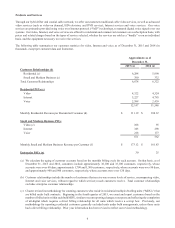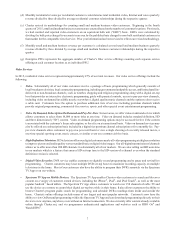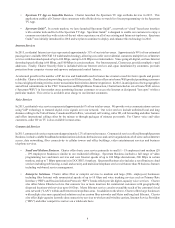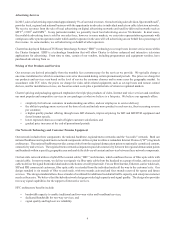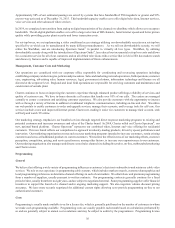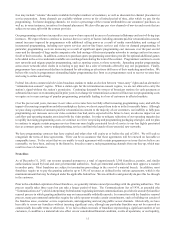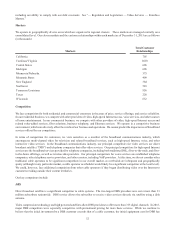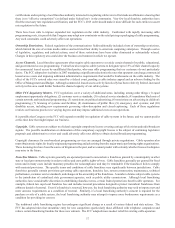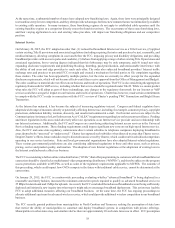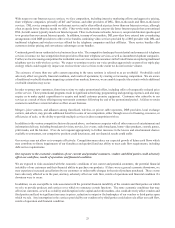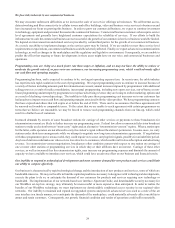Charter 2015 Annual Report Download - page 29
Download and view the complete annual report
Please find page 29 of the 2015 Charter annual report below. You can navigate through the pages in the report by either clicking on the pages listed below, or by using the keyword search tool below to find specific information within the annual report.14
Additionally, we are subject to limited competition from utilities and/or municipal utilities that possess fiber optic transmission
lines capable of transmitting signals with minimal signal distortion.
Traditional Overbuilds
Cable systems are operated under non-exclusive franchises historically granted by state and local authorities. More than one cable
system may legally be built in the same area. Franchising authorities may grant a second franchise to another cable operator that
may contain terms and conditions more favorable than those afforded us. Well-financed businesses from outside the cable industry,
such as public utilities that already possess fiber optic and other transmission lines in the areas they serve, have in some cases
become competitors. There are a number of cities that have constructed their own cable systems, in a manner similar to city-
provided utility services. There also has been interest in traditional cable overbuilds by private companies not affiliated with
established local exchange carriers, including Google Fiber. Constructing a competing cable system is a capital intensive process
which involves a high degree of risk. We believe that in order to be successful, a competitor’s overbuild would need to be able
to serve the homes and businesses in the overbuilt area with equal or better service quality, on a more cost-effective basis than we
can. Any such overbuild operation would require access to capital or access to facilities already in place that are capable of
delivering cable television programming. We cannot predict the extent to which additional overbuild situations may occur.
Broadcast Television
Cable television has long competed with broadcast television, which consists of television signals that the viewer is able to receive
without charge using an “off-air” antenna. The extent of such competition is dependent upon the quality and quantity of broadcast
signals available through “off-air” reception, compared to the services provided by the local cable system. Traditionally, cable
television has provided higher picture quality and more channel offerings than broadcast television. However, the recent licensing
of digital spectrum by the FCC now provides traditional broadcasters with the ability to deliver HD television pictures and multiple
digital-quality program streams, as well as advanced digital services such as subscription video and data transmission.
Internet Delivered Video
Internet access facilitates the streaming of video, including movies and television shows, into homes and businesses. Online video
services include those offered by Hulu, Netflix, Amazon and Apple. Increasingly, content owners are using Internet-based delivery
of content directly to consumers, some without charging a fee to access the content. Further, due to consumer electronic innovations,
consumers are able to watch such Internet-delivered content on televisions, personal computers, tablets, gaming boxes connected
to televisions and mobile devices. In 2015, HBO, Showtime and CBS began selling their programming direct to consumers over
the Internet. DISH Network launched Sling TV which includes ESPN among other programming, and Sony launched Playstation
Vue which includes 85+ TV channels. Charter views online video distributors as complementary and has developed a cloud-based
guide that can incorporate video from on-line video services. We believe some customers have chosen or will choose to receive
video over the Internet rather than through our video on demand and subscription video services, thereby reducing our video
revenues which may be offset by increases in our Internet revenues. We cannot predict the impact that Internet delivered video
will have on our revenues and adjusted EBITDA as technologies continue to evolve.
Private Cable
Additional competition is posed by satellite master antenna television systems, or SMATV systems, serving MDUs, such as
condominiums, apartment complexes, and private residential communities. Private cable systems can offer improved reception
of local television stations, and many of the same satellite-delivered program services that are offered by cable systems. Although
disadvantaged from a programming cost perspective, SMATV systems currently benefit from operating advantages not available
to franchised cable systems, including fewer regulatory burdens and no requirement to service low density or economically
depressed communities. The FCC previously adopted regulations that favor SMATV and private cable operators serving MDU
complexes, allowing them to continue to secure exclusive contracts with MDU owners. This regulatory disparity provides a
competitive advantage to certain of our current and potential competitors.
Other Competitors
Local wireless Internet services operate in some markets using available unlicensed radio spectrum. Various wireless phone
companies are now offering third and fourth generation (3G and 4G) wireless high-speed Internet services with fifth generation
(5G) and faster services on the horizon. In addition, a growing number of commercial areas, such as retail malls, restaurants and
airports, offer Wi-Fi Internet service. Numerous local governments are also considering or actively pursuing publicly subsidized
Wi-Fi Internet access networks. Operators are also marketing PC cards and “personal hotspots” offering wireless broadband
access to their cellular networks. These service options offer another alternative to cable-based Internet access. In addition, certain




